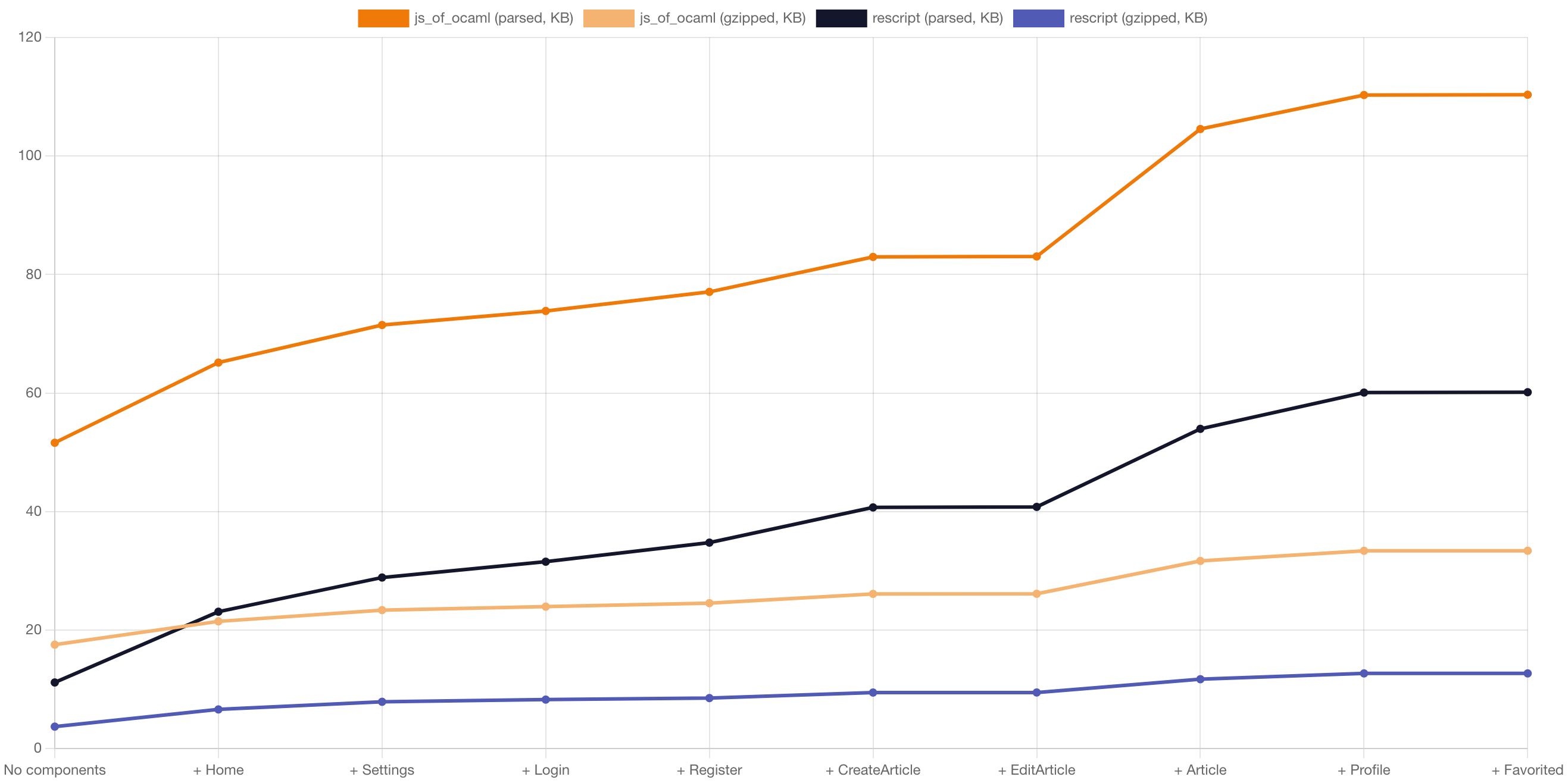Javier Chávarri
About
Js_of_ocaml: a bundle size study
An analysis about JavaScript bundle size in Js_of_ocaml with a real world app
January 23, 2022
Historically, I have noticed a recurring theme in OCaml forums and Discord, where from time to time someone mentions that Js_of_ocaml —a compiler that converts from OCaml bytecode to JavaScript— generates large output files.
However, my experience was generally the opposite. When using Js_of_ocaml production builds (using --profile=prod flag), the resulting JavaScript artifacts were quite small, as the compiler applies very aggressive dead code elimination.
It is however true that Js_of_ocaml allows to use many OCaml libraries that were written with native use cases in mind, where binary size is not generally an issue. Js_of_ocaml also requires some conversions between OCaml native types and JavaScript types, and the fact that it generates JavaScript from bytecode makes the whole process more opaque.
So, are Js_of_ocaml generated files really that large, as the rumors suggest? I ran a small experiment to find some answers.

Photo by Kai Dahms on Unsplash
Hypothesis
The main theory that I wanted to prove is that Js_of_ocaml produces reasonably sized JavaScript files. I also was interested about tracking the evolution in size of these output files over time, as the application keeps being developed and grows. If the output file is small for small apps, but grows too quickly over time, it would mean Js_of_ocaml would not be suitable for web applications that have limited bundle size budgets, or products that need to grow sustainably in the long term.
In order to answer the above question, I thought it would be nice to use one of the most efficient compilers to JavaScript that exist out there: ReScript. Which happens to be very close to OCaml as well. In a previous article I compared both compilers and the trade-offs between them.
The experiment
To run the experiment, I looked for an existing ReScript application that had some functionality that is common to most web applications:
- data fetching and pushing from/to servers
- client-side routing
- parsing of JSON
- collections and other data processing
I found a good candidate in jihchi/rescript-react-realworld-example-app. This application uses ReScript and rescript-react —the ReScript bindings to React.js— to build another example of the "mother of all demo apps". This demo app is a social blogging site (i.e. a Medium.com clone) that uses a custom API for all requests, including authentication.
To compare apples to apples, the plan became to migrate this application fully to Js_of_ocaml. Then, as the application consists on a dozen of screens or so, there was an easy way to produce JavaScript output files and take measurements of these files progressively, as new screen components were added to the application.
To do the experiment I leveraged jsoo-react to replicate the behavior found in the original ReScript app. jsoo-react are the bindings to React.js for Js_of_ocaml. This bindings library was originally based on rescript-react, but over time grew apart, with jsoo-react having more emphasis on supporting OCaml syntax.
Methodology
Both bundles are generated using Webpack v4.46.0 in production mode, to avoid differences in minimization or bundling. The bundles are analyzed using webpack-bundle-analyzer.
The results shared below were created from these commits:
For each case, all components in the main App component were commented, and then uncommented progressively, while running these commands on each step of the way:
- Js_of_ocaml:
make build-prod && yarn webpack:analyze - ReScript:
yarn build && yarn webpack:analyze
Results
The results are published together with the Webpack bundle analyzer reports in https://jchavarri.github.io/jsoo-react-realworld-example-app/bundle-study/.
Note the Stat column does not provide very valuable information. The reason why it is so large in ReScript case is that Js_of_ocaml generated JavaScript has already been minified by the Js_of_ocaml compiler (because of the profile=prod flag), while ReScript produces human readable JavaScript and offers no way to minify the output code.
In any case, in the end Webpack minifier runs in both cases, so the Parsed and Gzipped columns are the meaningful ones.
Js_of_ocaml
| Component | Stat | Parsed | Gzipped |
|---|---|---|---|
| No page components | 55.15 KB | 51.61 KB | 17.54 KB |
| + Home | 68.95 KB | 65.14 KB | 21.47 KB |
| + Settings | 75.45 KB | 71.48 KB | 23.37 KB |
| + Login | 77.86 KB | 73.85 KB | 23.96 KB |
| + Register | 81.01 KB | 77.07 KB | 24.55 KB |
| + CreateArticle | 87.09 KB | 82.97 KB | 26.11 KB |
| + EditArticle | 87.17 KB | 83.05 KB | 26.13 KB |
| + Article | 109.45 KB | 104.55 KB | 31.67 KB |
| + Profile | 115.52 KB | 110.29 KB | 33.38 KB |
| + Favorited | 115.58 KB | 110.34 KB | 33.39 KB |
ReScript
| Component | Stat | Parsed | Gzipped |
|---|---|---|---|
| No page components | 307.61 KB | 11.16 KB | 3.71 KB |
| + Home | 328.29 KB | 23.10 KB | 6.61 KB |
| + Settings | 349.47 KB | 28.87 KB | 7.9 KB |
| + Login | 359.54 KB | 31.54 KB | 8.27 KB |
| + Register | 372.67 KB | 34.76 KB | 8.53 KB |
| + CreateArticle | 391.85 KB | 40.7 KB | 9.46 KB |
| + EditArticle | 392.13 KB | 40.79 KB | 9.47 KB |
| + Article | 420.48 KB | 53.96 KB | 11.71 KB |
| + Profile | 435.64 KB | 60.08 KB | 12.69 KB |
| + Favorited | 435.91 KB | 60.14 KB | 12.69 KB |
Chart

Caveats and learning
Runtime size
It is obvious from the analysis and data above that Js_of_ocaml runtime is larger than ReScript runtime (51.61 KB vs 11.16 KB in the "No page components" case). Part of this is due to design decisions of both compilers, and there is no way around it. Js_of_ocaml needs more code as it has to provide conversion functions for types like string, while ReScript just does not.
But I believe part of this runtime could be reduced with some careful optimizations. Js_of_ocaml runtime implementation could remove some of the runtime code if it stopped using functors for internal implementations (see more below), or gave more control to users over what functionality is available. For example, there is a "synthetic" file system available in Js_of_ocaml that gets included in bundle through the caml_fs_init call, but this is not required for the large majority of applications.
All this means that if your application has very tight bundle budgets, ReScript is probably the better choice here, or just plain JavaScript.
Printf module
Unlike the original ReScript application, where JSON encoders were written manually, in the Js_of_ocaml version I decided to use some tool to generate encoders and decoders to work with the JSON values that result from interacting with the public API.
After some research I decided to use ppx_jsobject_conv. This tool turned out to be a great choice as it leverages all the infrastructure from ppxlib, so it is robust and very easy to use.
However, one small thing was that it made some usage of the Printf functions. Printf has a complex implementation, and it increases the bundle quite significantly. Fortunately, the usages in ppx_jsobject_conv were quite limited and were removed without much hassle.
In general, it is recommended to avoid using Printf functions if the bundle size budget for a Js_of_ocaml application is very limited.
This same problem is found in ReScript, which recently removed support for Printf module altogether.
Functors
A noticeable increase can be seen in Js_of_ocaml bundle sizes when the Article component gets added to the bundle. While ReScript app only increases by ~13KB (from 40.79 to 53.96), the Js_of_ocaml app increased by ~21KB (from 83.05 to 104.55).
This bump is due to a couple of modules that are created using OCaml Set.Make functor.
Apparently, functors can not be dead code eliminated by the compiler, so all the functions that are part of the Set module will appear in the resulting bundle, regardless if they are used or not. The good news is that the functions only appear once, so as an application grows more (and more functions from Set are used, and more times the functor is called), the cost would remain constant.
This problem is something that ReScript has tackled by re-implementing modules like Set in its standard library Belt in a way that they don't use functors. Maybe something similar could be done for Js_of_ocaml.
Leverage existing browser APIs
One way to keep bundle size limited is to use the browser APIs, for the cases when they are available.
For example, instead of lwt, the project is using promise-jsoo.
Instead of ppx_yojson_conv the project uses the aforementioned ppx_jsobject_conv. The advantages of the latter is that it delegates the parse step from string to JSON to browser APIs like JSON.parse or Response.json. This removes the need of bundling additional code, and most probably leads to faster applications, as browser implementors have optimized these functions heavily over time.
Functions with lots of optional values
One realization that might be surprising is that all applications of functions with optional labelled arguments get compiled to a bunch of comma-separated zeroes when the arguments are not passed.
This is fine for functions that take a few arguments, but in jsoo-react case there was a function to create style blocks that was taking more than 300 optional labelled arguments 😅. Ultimately, the issue was solved by changing the API to use a list, but it is still something that might be interesting to solve at the compiler level (e.g. if Js_of_ocaml supported some way of creating JavaScript objects inline, in a way that doesn't impact bundle size).
Conclusion
The measurements show that Js_of_ocaml version of the application has a larger initial cost, due to the runtime being larger than that of ReScript.
It also shows some larger increases due to functors, that could be fixed using alternatives like some bindings to JavaScript objects, or a reimplementation of Set that does not use functors.
But otherwise, for most of the incremental steps, Js_of_ocaml shows mostly the same bundle size increases than ReScript. The bundle size of both apps remain in the same order of magnitude, and it would be expected that as more components are added to the application, the difference become smaller.
This study also shows that regardless which compiler is used to generate JavaScript, some tooling and integrations with continuous integration pipelines will always be valuable, as it is quite easy to run into bundle size increases in unexpected ways.
We might revisit this study in the future to incorporate improvements, in which case I will add notes to this post.
I hope you enjoyed the study, if you want to share any other caveats that are missed, or there is anything inaccurate or that can be improved, feel free to reach out on Twitter.
Thanks to Glenn and Dave for reviewing earlier versions of this post and making it better 🙌.